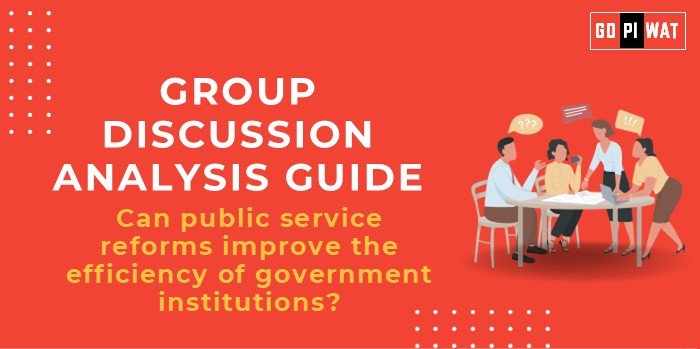📋 Group Discussion (GD) Analysis Guide: Can Public Service Reforms Improve the Efficiency of Government Institutions?
🌐 Introduction to the Topic
- 📖 Opening Context: Public service reforms are a cornerstone of modern governance, aimed at enhancing transparency, accountability, and performance in government institutions. Globally, countries like Singapore and Estonia are examples of how reforms can drive efficiency, while many nations still grapple with bureaucratic inertia.
- 💡 Topic Background: Public service reforms typically include digitization, decentralization, capacity building, and policy overhauls. India’s efforts, such as the Mission Karmayogi program for bureaucratic skill enhancement, highlight this global trend’s domestic relevance.
📊 Quick Facts and Key Statistics
- 💰 Mission Karmayogi Budget: ₹500 crore (FY 2023-24) – Largest capacity-building initiative for Indian civil servants.
- 📈 World Bank Data: Countries implementing public sector reforms see up to 20% improvement in service delivery.
- 🌍 Ease of Doing Business: India improved from rank 142 in 2014 to 63 in 2022, partly due to administrative reforms.
- 📊 Global Benchmarks: Singapore ranks 1st in public service efficiency (World Economic Forum 2022).
👥 Stakeholders and Their Roles
- 🏛️ Government Institutions: Drive reforms, adopt new policies, and lead implementation.
- 📡 Civil Society Organizations: Monitor, advocate, and ensure transparency.
- 🌐 International Agencies: Provide funding, expertise, and benchmarks (e.g., UNDP, World Bank).
- 🙋 Citizens: Demand accountability and engage in participatory governance.
🏆 Achievements and Challenges
✨ Achievements:
- 💻 Digitization: India’s DigiLocker with 400M+ users eases document access.
- ⚡ E-Governance: Rajasthan’s digitized districts reduce service delays by 45%.
- 🎓 Capacity Building: PMGDISHA trained over 6.7 crore citizens in digital literacy.
⚠️ Challenges:
- 🛑 Resistance to Change: Bureaucratic inertia hinders implementation.
- 🌐 Rural Access: Only 20% of rural households have reliable internet.
- 🔒 Cybersecurity: Rising threats, as seen in the 2022 AIIMS cyberattack.
Global Comparisons:
- 🇪🇪 Estonia: Fully digitized public services.
- 🇨🇳 China: Scaled smart city governance models.
📄 Structured Arguments for Discussion
- 👍 Supporting Stance: “Reforms like Mission Karmayogi can bridge efficiency gaps by enhancing bureaucratic skills.”
- 👎 Opposing Stance: “The absence of robust accountability mechanisms often renders reforms ineffective.”
- ⚖️ Balanced Perspective: “While public service reforms have shown promise, their success depends on addressing systemic bottlenecks.”
💬 Effective Discussion Approaches
- 🎯 Opening Approaches:
- 📚 “Public service reforms in countries like Singapore have transformed governance; can India replicate such models?”
- 📈 “Despite significant investments, gaps in implementation still challenge reforms like Digital India.”
- 🤝 Counter-Argument Handling:
- ✅ Example: “Resistance to reforms can be countered through targeted capacity-building programs like Mission Karmayogi.”
🔎 Strategic Analysis of Strengths and Weaknesses
- 💪 Strengths: Established digital frameworks (e.g., DigiLocker), global partnerships for reform funding.
- ❌ Weaknesses: Uneven regional implementation, limited rural penetration.
- 🌟 Opportunities: Integration of AI in governance, enhanced citizen participation through digital platforms.
- ⚠️ Threats: Data breaches and privacy concerns.
🎓 Connecting with B-School Applications
- 🌍 Real-World Applications: Discuss reform impact on areas like policy-making, operations, and public-private partnerships.
- 📝 Sample Questions:
- 💡 “How can public service reforms aid India’s economic growth?”
- 🔍 “Evaluate the role of technology in transforming governance efficiency.”
- ✨ Insights for B-School Students:
- 📖 Use SWOT for assessing policy effectiveness.
- 📚 Understand global reform benchmarks for strategic recommendations.


